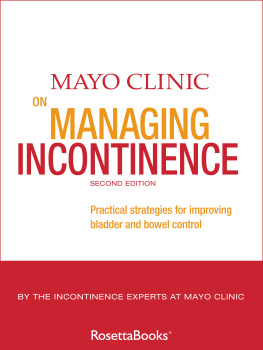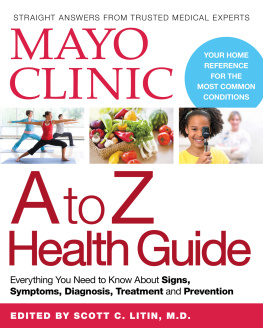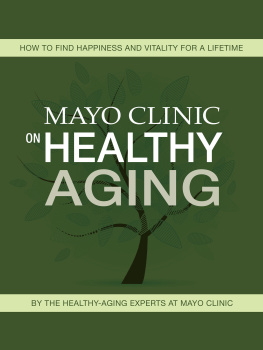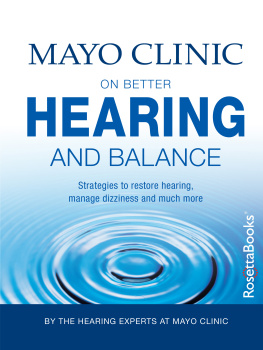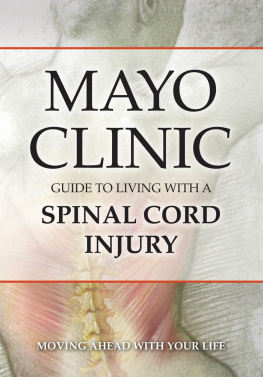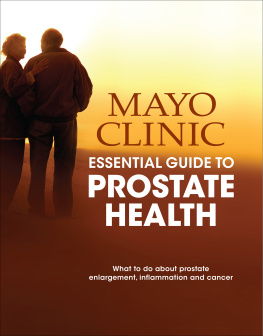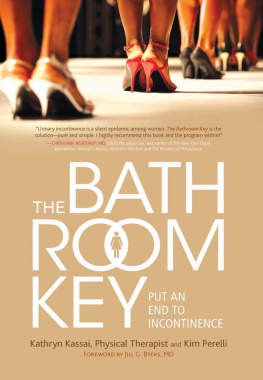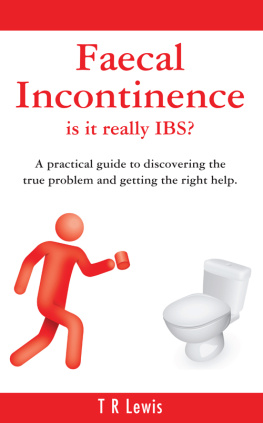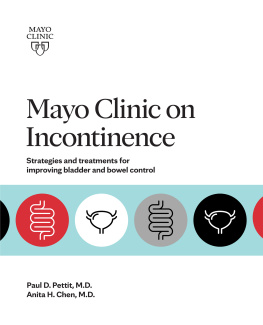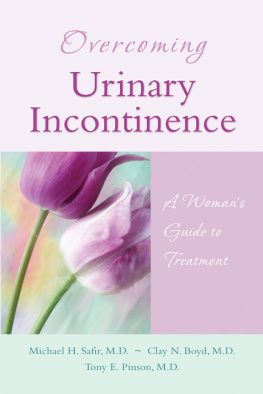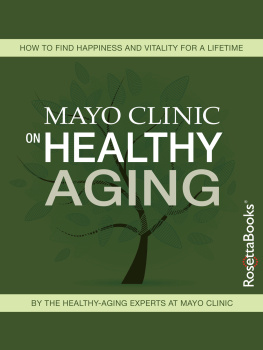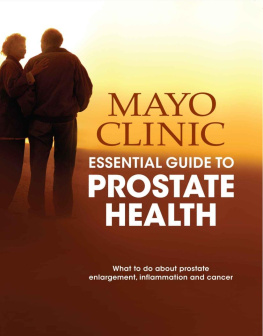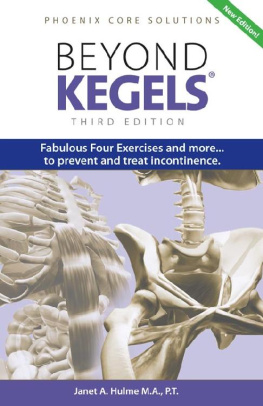
MAYO CLINIC
ON MANAGING
INCONTINENCE
Christopher J. Klingele, M.S., M.D.
Paul D. Pettit, M.D.
Medical Editors
Mayo Clinic on Managing Incontinence provides reliable information about getting help for incontinence. Much of the information comes directly from the experience of health care professionals at Mayo Clinic. This book supplements the advice of your personal physician, whom you should consult for individual medical problems.
This book does not endorse any company or product. MAYO, MAYO CLINIC and the Mayo triple-shield logo are marks of Mayo Foundation for Medical Education and Research.
All rights reserved. No part of this book may be reproduced or used in any form or by any means, electronic or mechanical, including photocopying and recording, or by any information storage and retrieval system, without permission in writing from the publisher, except by a reviewer, who may quote brief passages in review.
For bulk sales to employers, member groups and health-related companies, contact
Mayo Clinic Health Solutions, 200 First St. SW,
Rochester, MN 55905, or send an email to
SpecialSalesMayoBooks@Mayo.edu.
Published by Mayo Clinic
2014 Mayo Foundation for Medical Education and Research (MFMER)
Second Edition
ISBN ePub edition: 9780795342028
Editorial staff
Medical Editors
Christopher J. Klingele, M.S., M.D.
Paul D. Pettit, M.D.
Managing Editor
Karen R. Wallevand
Editorial Director
Paula Marlow Limbeck
Product Manager
Christopher C. Frye
Contributors
Heidi K. Chua, M.D.
Candace F. Grandberg, M.D.
Randina Harvey Springer, R.N., C.N.P.
Amy E. Krambeck, M.D.
Deborah J. Lightner, M.D.
John A. Occhino, M.D.
Emanuel C. Trabuco, M.D.
Research Librarians
Anthony J. Cook
Amanda K. Golden
Deirdre A. Herman
Erika A. Riggin
Creative Director
Daniel W. Brevick
Art Director
Richard A. Resnick
Illustration and Photography
Joanna R. King
Michael A. King
M. Alice McKinney
Proofreading
Miranda M. Attlesey
Donna L. Hanson
Julie M. Maas
Indexing
Steve Rath
Administrative Assistant
Beverly J. Steele
Preface
This book is intended to be a source of hope for all people who experience bladder and bowel control problems. Our message is that incontinence isnt something you need to live with. Most incontinence can be improved or cured. A variety of therapies from changes in lifestyle to minimally invasive procedures to surgery can help with this common condition.
In recent years, a number of advances have been made in the treatment of both urinary and fecal incontinence. Newer medications have been approved. Minimally invasive treatments such as bulking agents and Botox injections now provide additional treatment options. Procedures such as sacral nerve stimulation are seeing greater use. In addition, advances have been made in surgical procedures to treat more severe symptoms.
We hope this book helps you gain a better understanding of incontinence, and that it serves as a guide to getting effective medical care so that you can lead a full and active life.
Christopher J. Klingele, M.S., M.D.
Paul D. Pettit, M.D.
Medical Editors

Christopher J. Klingele, M.S., M.D., is a gynecologic and reconstructive pelvic surgeon at Mayo Clinic, Rochester, Minn., and an assistant professor of obstetrics-gynecology at College of Medicine, Mayo Clinic. Dr. Klingele is the medical director of the Urogynecology Incontinence and Pelvic Reconstructive Surgery Clinic. He is also a Female Pelvic Medicine and Reconstructive Surgery Fellowship faculty member.

Paul D. Pettit, M.D., is a gynecologic surgeon at Mayo Clinic, Jacksonville, Fla., and an assistant professor of gynecology at College of Medicine, Mayo Clinic. He is the director of the Gynecologic Continence Program at Mayo Clinic, Jacksonville.
Table of contents
Getting help
While on your way to the shopping mall, do you review in your head the location of the bathrooms at each of your favorite stores? When youre out having fun with family and friends, do you consciously try not to laugh for fear you might wet your pants? When you cough or sneeze, do you leak urine? As you insert the key into the lock on the door to your house or apartment, are you overwhelmed by an uncontrollable urge to go to the bathroom?
Or, maybe, you have a similar, but different, problem. When you pass gas, do you also pass stool? Does stool leak onto your underwear without any warning? When you do feel the urge to move your bowels, are there times you cannot make it to the bathroom on time?
If you answered yes to any of these questions, you may have incontinence. Incontinence is the involuntary loss of urine or stool. Urinary incontinence is very common, affecting millions of people of all ages. Its most prevalent in middle to older age women. Fecal incontinence is less common and is more likely to occur in older adults. Some people have both urinary and fecal incontinence.
So if you think youre the only one dealing with this often embarrassing condition, think again; youre not.
Whats important to know is that no matter how bothersome your symptoms whether your incontinence is more of an annoyance or its severe enough that youre afraid to leave the house there are steps that you can take to manage or treat the problem. Incontinence is not something you need to live with, and it shouldnt keep you from enjoying an active life.
Who to see
So, where do you go? Who do you see? How do you get help for incontinence? If you have a primary care provider, making an appointment with him or her is probably a good place to start. General practitioners, family practitioners, general internists, physician assistants and nurse practitioners often can treat incontinence, especially mild symptoms. However, not all primary care providers have the necessary interest, training or experience to treat the condition. And some may take the view that incontinence is an inevitable consequence of aging and theres not a lot you can do about it.
If your primary care doctor doesnt seem to have a positive attitude about treating your condition, he or she seems uninformed when discussing the subject, or you just dont feel satisfied that youre receiving appropriate care, consider looking for another provider. You might find it most helpful to see a specialist.
Who specializes in treatment for incontinence? There are a few different options. The specialist you should see depends on the type of incontinence you have and whether youre male or female.
Female pelvic medicine and reconstructive surgery specialist
This is a new medical subspecialty. An individual with these credentials is an obstetrician-gynecologist (OB-GYN) or a urologist who has received additional training in diseases and disorders affecting a womans pelvic floor. The pelvic floor is the network of muscles, ligaments, connective tissue and nerves that help support and control the rectum, uterus, vagina and bladder.
A female pelvic medicine and reconstructive surgery specialist previously known as a urogynecologist has passed board examinations in this specialty area and is certified to treat women with complex benign pelvic conditions, lower urinary tract disorders, pelvic floor dysfunction and defecatory disorders. You might ask to be referred to a female pelvic medicine and reconstructive surgery specialist if an individual with this type of training is available within your health care network.
Next page
